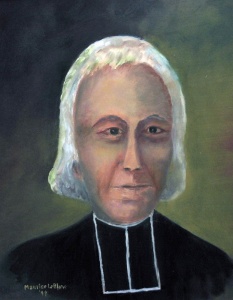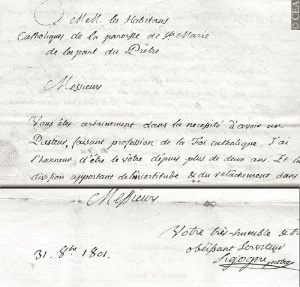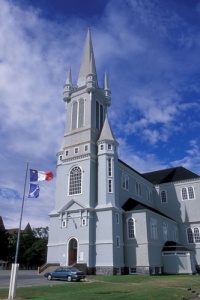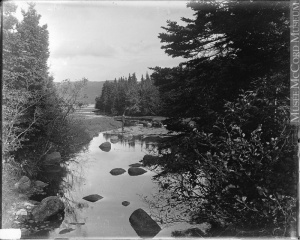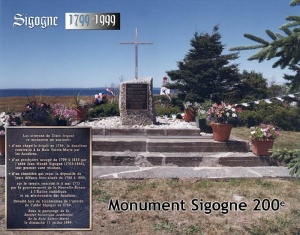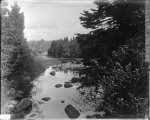Father Sigogne and Nova Scotia’s Acadian Heritage
par Boudreau, Gérald C.
Jean-Mandé Sigogne, born in France on April 6th, 1763, was ordained a parish priest in 1787. He went into exile in England five years later to escape the French Revolution and in 1799, he agreed to travel to Acadia (present-day Nova Scotia). There he founded the parishes of Cap-Sable and Baie Sainte-Marie, which were composed of destitute Acadians who had reassembled after the Deportation (1755-1763). In his 45 years in the region, he helped build nine churches, founded schools and secured major land grants for the Acadian people. Father Jean-Mandé Sigogne died on November 9th, 1844, after exerting a profound and lasting influence on the region. He lives on in the memory of Nova Scotian Acadians through his writings, the region's heritage buildings and a number of monuments erected in his honour.
Article disponible en français : Abbé Sigogne et le patrimoine acadien de la Nouvelle-Écosse
Father Sigogne's Remarkable Influence
No one was left indifferent to Jean Sigogne's tenure as a missionary in Acadia--neither contemporary British authorities, nor the biographers who hailed him posthumously as a saint, the saviour of the Acadian people and the restorer of Acadia itself. Sigogne's personal style, steeped as it was in official Church doctrine and characterised by respect for the principles upheld by the Magisterium, had a profound impact on the religious practices of the Acadian people. He worked tirelessly towards instilling in them a sense of strict religious discipline that forbade any deviation from the rules of the Church and the orders of the episcopate. (NOTE1) Despite the trials and tribulations he was subjected to by his followers, (NOTE2) Sigogne finally succeeded in earning not only their respect, but also - notably - that of the province's English officials. He left a lasting impression on the Acadians, whom he served faithfully until his death in 1844 with devotion, as a pastor, a founder of schools and churches, a teacher and a defender of human rights.
Sigogne's influence on the religious, social, cultural and economic life of the Acadians, the ancestors of those who still live in South-western Nova Scotia, was remarkable. He devoted the last 45 years of his life to a people who, like him, had felt the pangs of exile and he even wrote of his mission to shepherd the Acadians home after their Great Upheaval. A prolific writer, Sigogne wrote abundantly on the ways in which he presented the truths of the Catholic faith to his parishioners. It was inevitable that the Acadians, who were constantly faced with this type of teaching (and who were predisposed to trust an official representative of the Church), would be very much influenced by such a passionate preacher.
Father Sigogne left behind an estimated 2,000-plus handwritten pages, which are preserved in a number of archives across the country. The most important collections of his writings are found in the National Archives of Canada, the Centre Acadien de l'Université Sainte-Anne, the Centre d'Études Acadiennes de l'Université de Moncton and in the parish of Sainte-Anne-du-Ruisseau (Nova Scotia). These manuscripts are an important historical artefact, not only because of their rarity in the early 19th century, but also because of the meticulousness and detail of Sigogne's observations on the socio-religious life of the Acadians he was sent to look after. Thanks to his curious nature and keen sense of observation, contemporary readers now have access to a plethora of examples of 19th-century preaching. For these reasons, Sigogne's manuscripts are exceptionally valuable for Acadian historiography. It is a shame, however, that there are very few contemporary texts that analyse his observations.
The Founder
Sigogne, a civic-minded individual, approached Nova Scotia's English officials on a number of occasions about creating schools, obtaining sizeable land grants for the Acadian people and building a variety of infrastructure (bridges, breakwaters, etc.). His mediation allowed the Acadians to assert themselves more strongly and to experience a level of prosperity whose effects are still felt today. But it was his efforts to build churches and rectories that set Father Sigogne apart from his peers. (NOTE3)
Father Sigogne consecrated his first two churches on Acadian soil - St. Mary's and St. Anne's - in 1808. Their rectories, completed in 1810 and 1814, respectively, were also his first. In 1815, Sigogne blessed St. Peter's church in Pubnico-ouest, in Cap-Sable. All of the works that he accomplished immediately thereafter were located in the Baie Sainte-Marie area: St. Mande's church in Meteghan in 1817; a second church in Sainte-Marie in 1821, along with a new rectory to replace the two mentioned earlier, which had been destroyed by firein 1820 (NOTE4); St. Francis Xavier church in Bear River (1831) (NOTE5); St. Patrick's church in Digby (1834); St. Jean Baptiste church in Corberrie (1837); and finally St. Croix church in Plympton (1838).
Only three of these institutions have survived the passage of time. First, there is the old St.Mary's rectory, built following the great fire of 1820 and moved to the town of Pointe-de-l'Église (Nova Scotia) in 1873, which has since become a private residence. Then, there is the St. Jean Baptiste church in Corberrie, whose future seems uncertain, particularly as no services have been held there since 2007. Finally, St. Patrick's church - now known as St. Anne's - is still used as a church in St. Patrick's parish in Digby (NS). All of the other buildings erected by Father Sigogne have since been replaced. There are regular services in all of the parishes he founded, although only the parishes of St. Peter's, St. Patrick's and St. Mande's - later renamed Stella Maris - have their own resident priest.
The Pastor
Father Sigogne's tireless physical and spiritual efforts had a profound and lasting impact on the faith of the Acadian people. In 1885, there were 17 churches in South-western Nova Scotia, where there had only been 7 at the time of his death. (NOTE6) Eudist priest Pierre-Marie Dagnaud, Sigogne's successor some sixty years later, writes of a noticeable improvement in the Acadians' religious situation:
"For them, religious life means respecting of all the duties imposed by the Catholic faith. Of course, there are those in our parishes who avoid the obligations of Easter, but the faithful gather in large numbers for Communion on major Christian holidays. The Virgin Mary is worshipped here with a fervour that I have rarely observed, even in the most devout Catholic parishes. An Acadian is never without his rosary, regardless of how long his faith is pushed aside at critical moments in his life, and what is equally curious is that even those who have more or less justifiable reasons for not receiving the sacraments for a certain length of time do not retire to bed without first offering their love and respect to the Virgin Mary." (NOTE7)
Preserving the Memory of a True Acadian Apostle
In 1889, Father Alphonse Parker, a priest in the parish of St. Bernard (located north of St. Mary's) from 1888 to 1905, along with Father Jean-Marie Gay, priest in St. Mary's from 1878 to 1890, began a campaign to raise funds for a monument commemorating Father Sigogne. (NOTE8) Newspapers - especially L'Évangéline and Le Moniteur Acadien - were immediately flooded with articles on Sigogne's work, fundraising requests and lists of donations made to the Sigogne Memorial. According to one article, "The monument will serve two purposes: to preserve the memory of a true Acadian apostle and to continue the work so laudably and generously begun by Father Sigogne. [...] We must commemorate this great benefactor and Christian hero with more than vain, useless columns of granite and marble; rather, if possible, the story of his sacrifices and triumphs must be preserved by actively continuing his good works; it is the way he himself would have chosen." (NOTE9) The same article goes on to discuss the best way of continuing such beneficial works. "It is simple; we must choose a centralised location and erect an educational institution, to be known as the Sigogne College or Academy." (NOTE10) And so, Mémorial Sigogne was founded in the fall of 1890, as a school of higher learning by Eudists sent from France for that express purpose. The institution was granted a university charter in 1892, first as Collège Sainte-Anne, then later as Université Sainte-Anne. (NOTE11) The university has remained the most lasting and influential monument to Father Sigogne's legacy.
A year before the Eudists' arrival, a carefully designed tombstone was commissioned by St. Mary's parish priest, Father Gay. The stone was placed on Sigogne's grave a few days before the Acadian Convention that was held from August 13th to 15th in 1890 in Pointe-à-l'Église, home of the college. The stone replaced the marble plaque that originally marked the grave, which is now on display in the St. Mary's parish museum. The Latin text engraved on the stone can be translated as follows:
"Great and powerful God, here lies the body of Father P.D. Jean Sigogne, French priest from the Province of Touraine, who, because of the upheavals of his day, was exiled from his home country for 47 years [actually 45 years] and came to Nova Scotia, where he served as a devout and faithful missionary and helped spread the Catholic faith. He passed away, filled with honour and greatly missed, on November 9th, 1844, at the age of 84 [actually 81]. Oh Lord, may he rest in peace. Amen."
The above epitaph is an eloquent testament to the esteem felt for the honourable missionary by the descendents of his original flock.
More recently, in 1999, Acadians celebrated the 200th anniversary of Sigogne's arrival in the area. Among the numerous ceremonies was the unveiling by Baie Sainte-Marie inhabitants of a permanent monument on the very site of the chapel that existed at the time of the missionary's arrival. In the 1930s, the Eudists had built a commemorative chapel at the same location, but it had fallen into ruin over the years. Nonetheless, its foundation had remained intact, and was used as a base for the newly-erected monument. A commemorative plaque reads as follows:
"This monument has been erected by the people of Clare in memory of:
- A chapel built by the Acadian people in Baie Sainte-Marie in 1786
- A rectory inhabited from 1799 to 1810 by Father Jean Mandé Sigogne (1763-1844), their first resident priest
- A cemetery that welcomed their deceased loved ones from 1786 to 1808, located on land granted to the Catholic Church and the Acadians' missionary by the government of Nova Scotia on May 8, 1775.
Unveiled for the 200th anniversary of Father Sigogne's arrival in 1799.
With the support of the Société Historique Acadienne de la Baie Sainte-Marie on Sunday, July 11th, 1999."
In this digital age, it is only natural that Father Sigogne have an electronic presence as well; his web site can be found at http://personnel.usainteanne.ca/sigogne/.
An Unforgettable Man
By studying Sigogne's life, it becomes clear just how (and to what extent) the constant, tireless efforts of this valiant past or among the Acadian people managed to create an atmosphere of peace and relative harmony. It seems that by the end of his life,the "muddle-headed," the "libertines" and the "non-believers" were a definite minority. A faithful and conscientious priest throughout his lifetime, Sigogne lives on in the collective memory of the Acadian people, who welcomed him in 1799, benefitted from his many services for nearly fifty years and whose descendents continue to bear witness to this unforgettable man's efforts.
Gérald C. Boudreau
Retired administrator, Université Sainte-Anne
NOTES
Note 1. Boudreau, Gérald C., Le père Sigogne et les Acadiens du sud-ouest de la Nouvelle-Écosse, St-Laurent (QC), Éditions Bellarmin, 1992, pp. 159-190.
Note 2. Ibid., pp. 77-102.
Note 3. Ibid., pp. 109-145.
Note 4. Ibid., pp. 138-140.
Note 5. Boudreau, Gérald C., "The Nujjinen of the Mi'kmaq People and the Construction of their Chapel at Bear River, Nova Scotia," Nova Scotia Historical Review,vol. 16, no. 1, 1996, pp. 7-20.
Note 6. Gaudet, Placide, "L'Abbé Jean-Mandé Sigogne," Courrier des ProvincesMaritimes (December 3rd, 1885), p. 1.
Note 7. Dagnaud, Pierre-Marie, Les Français du sud-ouest de la Nouvelle-Écosse. Le R. P. Jean-Mandé Sigogne, apôtre de la Baie Sainte-Marie et du Cap Sable, 1799-1844, Besançon, Librairie Centrale, 1905, pp. 245-246.
Note 8. Parker, Alph. B., "Le Mémorial Sigogne," L'Évangéline, July 17th, 1889. See also: Parker, Alph. B., "À la mémoire de l'abbé Jean-Mandé Sigogne," Le Moniteur acadien, vol. xxiii, no. 6, July 28th, 1889, p. 2.
Note 9. Ibid.
Note 10. Ibid.
Note 11. See LeBlanc, René et Micheline Laliberté, Sainte-Anne, collège et université, 1890-1990, Pointe-de-l'Église (NS), Chaire d'étude en civilisation acadienne de la Nouvelle-Écosse, 1990, 502 p. Particularly relevant is the first chapter: Le Mémorial Sigogne (1880-1890), pp. 3-29.
BIBLIOGRAPHY
----, Centenaire de la mort du Père Jean Mandé Sigogne. Missionnaire de la Baie Ste-Marie et premier curé de la paroisse Sainte-Marie (1844-1944), Yarmouth, The Lawson Publishing, 1944, 64 p.
Boudreau, Gérald C., "Traces matérielles et culturelles de l'apostolat du missionnaire Sigogne," Port Acadie, vol. 10-11-12, fall 2006 - spring 2007 - fall 2007, Proceedings of the Colloque national sur le Patrimoine religieux dela Nouvelle-Écosse (Signes et paradoxes en Acadie), June 19-20th, 2006, Université Sainte-Anne, pp. 23-36.
Boudreau, Gérald C., Le père Sigogne et les Acadiens du sud-ouest de la Nouvelle-Écosse, St-Laurent (QC), Éditions Bellarmin, 1992, 230 p.
Boudreau, Gérald C., Père Sigogne, l'ami des Acadiens, Pointe-de-l'Église (NS), Centre provincial de ressources pédagogiques, 1987, 20 p.
Boudreau, Gérald C. (Dir.), Les écrits du père Sigogne, volume 1, Pointe-de-l'Église (NS), Presses de l'Université Sainte-Anne, 1987, 136 p.
Boudreau, Gérald C. (Dir.), Sigogne par les sources, Moncton (NB), Éditions d'Acadie, 1997, 204 p.
Collectif, "Actes du Colloque Sigogne 1987," Revue de l'Université Sainte-Anne, 1987, 119 p.
Bourgeois, Ph. F., Panégyrique de l'Abbé Jean Mandé Sigogne, Missionnaire français à la baie Ste-Marie, N.-Écosse, depuis 1799 jusqu'en 1844, Weymouth (NS), Imprimerie L'Évangéline, 1892, 34 p.
Braud, Alexandre, "Les Acadiens de la baie Sainte-Marie, » Revue du Saint-Coeur de Marie, du 15 janvier 1898 au 15 juin 1901, environ 100 p.
Dagnaud, Pierre-Marie, Les Français du sud-ouest de la Nouvelle-Écosse. Le R. P. Jean Mandé Sigogne, apôtre de la Baie Sainte-Marie et du Cap Sable, 1799-1844 ,Besançon (FR), Librairie Centrale, 1905, 278 p.
Additional DocumentsSome documents require an additional plugin to be consulted
Images
-
 Arrivée d'un bateau
Arrivée d'un bateau
à Digby Gut en... -
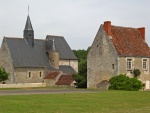 Beaulieu-lès-Loches,
Beaulieu-lès-Loches,
ville natale de... -
 Église Ste-Marie, à b
Église Ste-Marie, à b
aie Ste-Marie -
 Indienne mi'kmaq de N
Indienne mi'kmaq de N
ouvelle-Écosse...
-
 La rivière Salmon, N
La rivière Salmon, N
ouvelle-Écosse... -
 Lettre de Jean-Mandé
Lettre de Jean-Mandé
Sigogne -
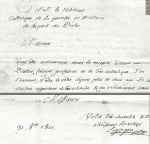 Lettre de Jean-Mandé
Lettre de Jean-Mandé
Sigogne, 1801 -
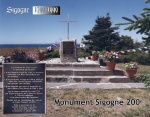 Photomontage du monum
Photomontage du monum
ent et de la pl...
Hyperliens
- Page du père Sigogne à l'Université Sainte-Anne [French only]
- Jean-Mandé Sigogne, Dictionary of Canadian Biography Online

